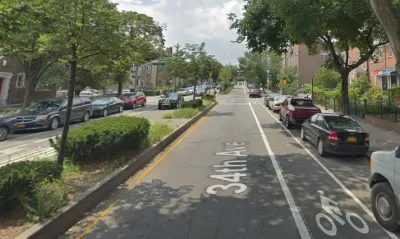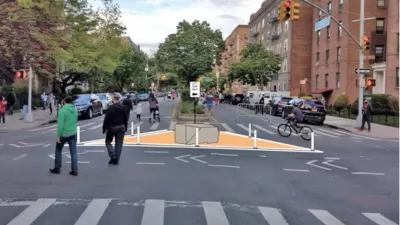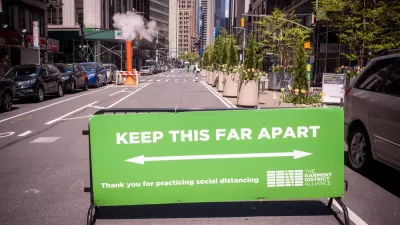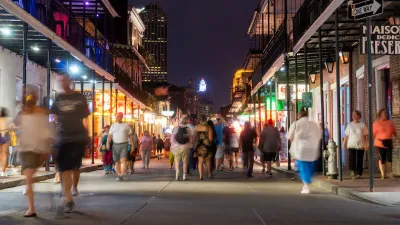A debate over one Queens 'open street' project illustrates the challenges of maintaining open streets.

Each day at 8 a.m., New York's 34th Avenue becomes off-limit to cars (with some exceptions). As Winnie Hu details in the New York Times, this 26-blocks stretch anchors a network of dozens of miles of open streets across the city that was created in response to the outbreak and provides a tantalizing glimpse of a future of traffic-free streets."
But "a push to make 34th Avenue into a 'linear park,' where cars would be permanently restricted, has provoked a backlash from some residents and drivers over what they see as an experiment gone too far," causing gridlock and making it "harder to find parking and get deliveries and services in a neighborhood where many depend on cars." A resident group called 34 Compromise seeks to scale back the open street program, in part by reducing the hours.
In New York City, "[t]he streets make up about 27 percent of the city’s total land area." According to urban planner Mike Lydon, "[p]rogramming them so they are not just mobility corridors is absolutely a lesson of the pandemic" and should remain at the heart of planning policy. 34th Avenue now plays host to social events, picnics, and performances that could continue to connect neighbors well beyond the pandemic. "[T]he battle over 34th Avenue goes beyond whether cars or people should have priority to a debate over how an open street adds to — or detracts from — a neighborhood’s rhythms."
FULL STORY: The Pandemic Gave New York City ‘Open Streets.’ Will They Survive?

Alabama: Trump Terminates Settlements for Black Communities Harmed By Raw Sewage
Trump deemed the landmark civil rights agreement “illegal DEI and environmental justice policy.”

Study: Maui’s Plan to Convert Vacation Rentals to Long-Term Housing Could Cause Nearly $1 Billion Economic Loss
The plan would reduce visitor accommodation by 25% resulting in 1,900 jobs lost.

Planetizen Federal Action Tracker
A weekly monitor of how Trump’s orders and actions are impacting planners and planning in America.

Waymo Gets Permission to Map SF’s Market Street
If allowed to operate on the traffic-restricted street, Waymo’s autonomous taxis would have a leg up over ride-hailing competitors — and counter the city’s efforts to grow bike and pedestrian on the thoroughfare.

Parklet Symposium Highlights the Success of Shared Spaces
Parklets got a boost during the Covid-19 pandemic, when the concept was translated to outdoor dining programs that offered restaurants a lifeline during the shutdown.

Federal Homelessness Agency Places Entire Staff on Leave
The U.S. Interagency Council on Homelessness is the only federal agency dedicated to preventing and ending homelessness.
Urban Design for Planners 1: Software Tools
This six-course series explores essential urban design concepts using open source software and equips planners with the tools they need to participate fully in the urban design process.
Planning for Universal Design
Learn the tools for implementing Universal Design in planning regulations.
Caltrans
Smith Gee Studio
Institute for Housing and Urban Development Studies (IHS)
City of Grandview
Harvard GSD Executive Education
Toledo-Lucas County Plan Commissions
Salt Lake City
NYU Wagner Graduate School of Public Service





























